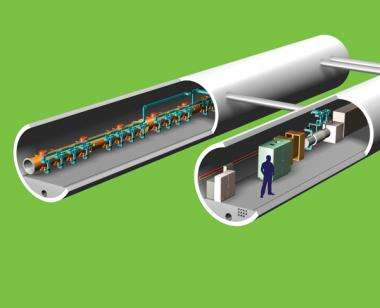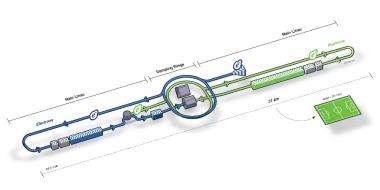July 26, 2010 report
Plans for an international linear electron smasher - the ILC

(PhysOrg.com) -- Physicists at the European particle physics laboratory CERN are planning a straight collider 31 kilometers long to complement the Large Hadron Collider (LHC) and help them explain the mysteries of the universe.
CERN's 27-kilometer ring atom smasher, the LHC, only became fully operational in March this year, but the scientists plan to start building a new International Linear Collider (ILC), at a cost of $6.7 billion, in 2012 to smash electrons and positrons together. The only other linear electron collider is the 3.2-kilometer-long Stanford Linear Accelerator built in 1962 in California.
The tunnel will use superconducting magnets to accelerate electrons and their antimatter equivalents, positrons, towards each other at near light speed. Construction is expected to take seven years. European director of the ILC project, Professor Brian Foster, said the linear collider would enable physicists to explore in more detail the findings of the LHC.
The ILC is expected to work with the LHC, which smashes protons together. Foster describes proton crashes as “dirty,” and said it’s like smashing two oranges together at 45 mph and hoping the pips hit each other head-on. In the proton, the “pips” are the quarks making up the proton, and often only one quark from each colliding proton will have a direct hit. Foster said the LHC is good at finding things, but it only gives physicists information on the maximum amount of energy a collision might involve, but tells them little about how the energy is distributed between quarks.
The ILC will give them more precise information on the high-energy frontier because it smashes electrons together, which are 2,000 times smaller than protons, and are not thought to contain sub-particles. When two electrons collide the released energy is known exactly. Electrons cannot be effectively collided in the LHC because the tunnel is a ring, and when electrons are bent by magnetic fields they emit X-rays, as do other particles. Electrons are so small that most of the energy pumped into an electron would only replace that lost as X-rays.

Some of the questions the ILC and LHC are attempting to answer include how many dimensions there are, why there are so many subatomic particles, what happened to the antimatter predicted by the Big Bang theory, and what does a Higgs particle (the so-called "God" particle) look like? The most prominent theory of how the universe works predicts the existence of a Higgs particle that gives matter its mass. If discovered, it could pave the way towards a unification of the theories of quantum and general relativity.
The location of the ILC is not finalized, but somewhere close to CERN's headquarters in Geneva is likely because most of the physicists who will want to use it are there. Around 700 scientists based at 300 universities and laboratories are already working on the project. The exact length is also not finalized, and will not be decided until the LHC identifies the energy ranges of most interest. At this point the energy levels are expected to be about 0.5 TeV.
A session of the International Conference on High-Energy Physics (ICHEP) in Paris this week is being devoted to the ILC and other next-generation colliders.
More information: ILC - www.linearcollider.org/
© 2010 PhysOrg.com
















